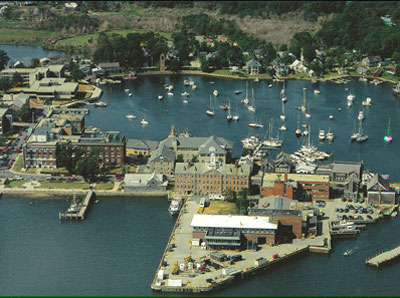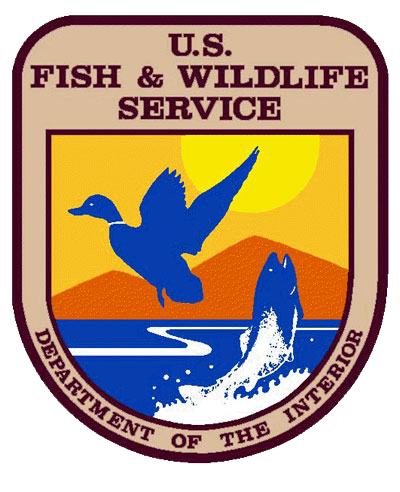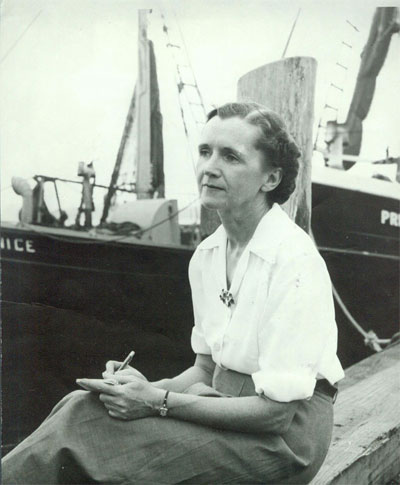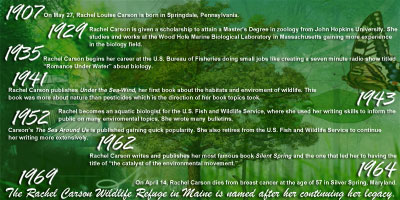Biography
Early Years
 Rachel Louise Carson was born in Springdale, Pennsylvania on May 27, 1907. She always had
a love for writing from a young age. At ten years old she had a piece published in a national
children’s magazine. Her love of writing and literature came from her mother as well as a
love for nature. Rachel’s mother was her inspiration in life. She was a school teacher and
a musician. Rachel was the shy but intelligent type. She did very well in high school and
went on to Pennsylvania College for Women where she changed her English major to marine biology when she was reconnected with science and her passion for it. In 1929, an amazing
opportunity for a woman arose, she was given a scholarship to attain a Master’s degree in
zoology at John Hopkins University. She gained some experience in the biology field by
studying and working at the Woods Hole Marine Biological Laboratory in Massachusetts.
Rachel Louise Carson was born in Springdale, Pennsylvania on May 27, 1907. She always had
a love for writing from a young age. At ten years old she had a piece published in a national
children’s magazine. Her love of writing and literature came from her mother as well as a
love for nature. Rachel’s mother was her inspiration in life. She was a school teacher and
a musician. Rachel was the shy but intelligent type. She did very well in high school and
went on to Pennsylvania College for Women where she changed her English major to marine biology when she was reconnected with science and her passion for it. In 1929, an amazing
opportunity for a woman arose, she was given a scholarship to attain a Master’s degree in
zoology at John Hopkins University. She gained some experience in the biology field by
studying and working at the Woods Hole Marine Biological Laboratory in Massachusetts.
Career
 Rachel Carson started her career at the U.S. Bureau of Fisheries in 1935 where she was in
charge of creating a seven minute radio show about marine biology called “Romance Under Water”.
Then in 1936 she was appointed a junior aquatic biologist becoming one of the only two women
working there as professionals. Carson moved from a junior aquatic biologist to an aquatic
biologist in 1943 for the new U.S. Fish and Wildlife Service where she spent much time using her
writing skills to inform the public on many environmental issues. She was a talented person
who made her way up for a woman in her time. As an aquatic biologist she created bulletins;
one bulletin, “Conservation in Action”, was very closely related to the whole purpose of the
U.S. Fish and Wildlife Service, a department dedicated to the conservation or protection of
wildlife. “Conservation in Action” was a bulletin that went in depth on the protection and
the environment of wildlife. Another one was “Food from the Sea” which tried to inform
Americans, a people whose diets consisted of mainly meat, of the benefits of a fish based diet.
Rachel Carson started her career at the U.S. Bureau of Fisheries in 1935 where she was in
charge of creating a seven minute radio show about marine biology called “Romance Under Water”.
Then in 1936 she was appointed a junior aquatic biologist becoming one of the only two women
working there as professionals. Carson moved from a junior aquatic biologist to an aquatic
biologist in 1943 for the new U.S. Fish and Wildlife Service where she spent much time using her
writing skills to inform the public on many environmental issues. She was a talented person
who made her way up for a woman in her time. As an aquatic biologist she created bulletins;
one bulletin, “Conservation in Action”, was very closely related to the whole purpose of the
U.S. Fish and Wildlife Service, a department dedicated to the conservation or protection of
wildlife. “Conservation in Action” was a bulletin that went in depth on the protection and
the environment of wildlife. Another one was “Food from the Sea” which tried to inform
Americans, a people whose diets consisted of mainly meat, of the benefits of a fish based diet.
Soon Rachel Carson gained the career that combined her two loves, writing and biology. She became the assistant editor and later editor-in-chief of the Fish and Wildlife Service where she created speeches for other members, was in charge of the library, and edited texts. For a woman in her time, she made great strides in the environmental field.
Carson published her first book Under the Sea-Wind in 1941. Any book she wrote gained popularity, her second book The Sea Around Us, was a huge sensation staying on the New York Times bestseller list and being translated into 32 languages. She decided she was in a good situation to retire from the U.S. Fish and Wildlife Service to continue her writing more extensively in 1952.
Later Years
 In her new position, she was able to write another book called, The Edge of the Sea, published in 1956 gave new meaning to the wildlife and environmental relationships
as well as our effects on our home, the Earth. Rachel Carson was a very knowledgeable scientist
who had completed much research in the biology field so she knew that she was the only one who
had the ability in addition to the time and money to write her most successful book
Silent Spring. With the help of former Fish and Wildlife Service employees, Shirley Briggs
and Clarence Cottam who gave Carson not only support but research on DDT (Dichlorodiphenyltrichloroethane), one of the main chemicals posing a problem mentioned in
her book. Carson also used years of research from the United States and Europe that she had
collected about pesticides and their effect on fish and wildlife something she took notice to
as a biologist. It was published in 1962.
In her new position, she was able to write another book called, The Edge of the Sea, published in 1956 gave new meaning to the wildlife and environmental relationships
as well as our effects on our home, the Earth. Rachel Carson was a very knowledgeable scientist
who had completed much research in the biology field so she knew that she was the only one who
had the ability in addition to the time and money to write her most successful book
Silent Spring. With the help of former Fish and Wildlife Service employees, Shirley Briggs
and Clarence Cottam who gave Carson not only support but research on DDT (Dichlorodiphenyltrichloroethane), one of the main chemicals posing a problem mentioned in
her book. Carson also used years of research from the United States and Europe that she had
collected about pesticides and their effect on fish and wildlife something she took notice to
as a biologist. It was published in 1962.
This book created controversy and she received attacks from the pesticide industry trying to defame or make her work seem untrue although she was only suggesting that chemicals be tested to assure that they were being used safely and that other chemicals were found to replace harmful ones such as DDT. She was brought before a Congressional committee to testify and the government conducted studies on their pesticide policies at the same time. Also, President Kennedy was influenced to do so after reading Silent Spring. DDT was banned after the results of this study and testimonials.
Rachel Carson was thought to be the catalyst of the new environmental movement after Silent Spring had been published. One of her main goals was to raise awareness on the environment and its issues among Americans who had been previously ignoring it for the most part. She died on April 14, 1964 in Silver Spring, Maryland at the age of 57 from breast cancer. Her legacy lives on through her books and through wildlife refuges like the Rachel Carson Wildlife Refuge in Maine being named after her in 1969.
Timeline
Please Click thumbnail for larger image.
